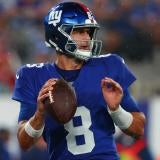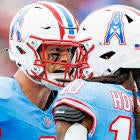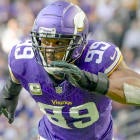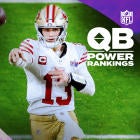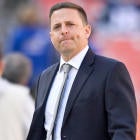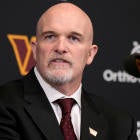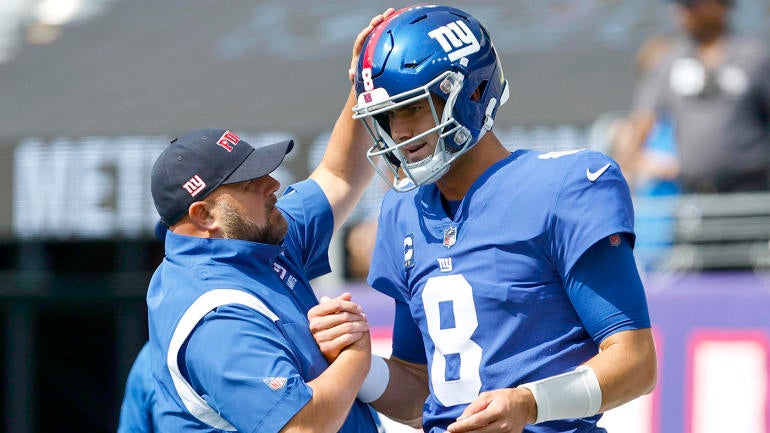
Last season, the New York Giants were one of the league's most pleasant surprises. New York looked like it was entering a teardown year in its first season under new general manager Joe Schoen and new head coach Brian Daboll. Instead, the G-Men finished the season 9-7-1, made the playoffs and won a first-round contest before bowing out against the eventual NFC champion Philadelphia Eagles.
While the Giants were actually outscored on the season and benefitted from both playing against a relatively light schedule and an inordinate amount of luck in close games (they went 8-3-1 in one-score contests), they showed a dramatic year-to-year improvement on offense. In their final season under Joe Judge, the Giants finished the season ranked 31st in both yards and points, and 32nd in Tru Media's expected points added (EPA) per play. In Year 1 under Daboll, New York spiked to 18th in yards, 15th in points and 12th in EPA per play.
Considering the Giants put up those numbers while being quarterbacked by a player (Daniel Jones) whose fifth-year option the team had justifiably declined months earlier, it was quite the accomplishment. Better yet, Daboll and offensive coordinator Mike Kafka actually turned Jones into a productive quarterback in 2022. Though a lack of volume and aggression limited him to just 15 touchdown passes, the fourth-year pro did complete a career-best 67.2% of his passes (317 of 472) for 3,205 yards (6.8 per attempt) and a career-low five interceptions. The Giants also weaponized Jones as a runner, unleashing him for a career-high 120 rushing attempts (his previous high was 65), which yielded 708 yards and seven additional scores.
The Giants are hoping Jones takes another step forward this season, beginning with Sunday night's Week 1 game against the Cowboys (8:20 p.m. ET, NBC).
The numbers paint a picture of a much-improved player. In addition to a career-best mark in completion percentage, Jones also was off-target with fewer throws than ever, and posted a career-low interception rate. All of that resulted in by far the best EPA per dropback figure of his career, among other career highs, per Tru Media.
| Season | EPA/DB | QBRtg | Comp% | OffTgt% | YPA | TD% | INT% |
|---|---|---|---|---|---|---|---|
| 2019 | -0.03 | 87.7 | 61.9% | 8.7% | 6.6 | 5.2% | 2.6% |
| 2020 | -0.10 | 80.4 | 62.5% | 11.2% | 6.6 | 2.5% | 2.2% |
| 2021 | -0.04 | 84.8 | 64.3% | 9.1% | 6.7 | 2.8% | 1.9% |
| 2022 | 0.05 | 92.5 | 67.2% | 7.2% | 6.8 | 3.2% | 1.1% |
The Giants lavished Jones with a monster contract (four years, $160 million, $82 million guaranteed) this offseason, so it is worth exploring exactly how he, Daboll and Kafka achieved these better results. In what areas did Jones improve (or not), and what does he still need to add to his game to take it to the next level and become a player who, instead of being carried along to success, is driving the success himself? We watched all 567 of Jones' dropbacks from last season, dove into the film and took a look at the numbers in order to find out.
Any discussion of Jones' 2022 season has to start with the fact the Giants got better results than ever out of him by minimizing his role in the offense as much as possible. This was not a situation all that similar to what Daboll had previously done with Josh Allen in Buffalo. With Allen, he and the team took off when the Bills put more on Allen's plate and built the entire ship around him. With Jones, it was the opposite.
He dropped back to pass a career-low 35.4 times per game, and he maintained a very low "true dropback" rate -- the share of his pass attempts that were not screens or play-action passes. He also threw shorter passes than ever before, averaging nearly a full air yard less per attempt in 2022 (6.4) than he did in 2021 (7.3). That 6.4 air yards per attempt figure ranked 32nd out of 33 qualifying quarterbacks, placing him ahead of only Matt Ryan. He often threw well short of the sticks as well: His average pass was intended for a receiver 2.7 yards away from a first down. That, too, ranked 32nd out of 33 qualifiers and placed Jones ahead of only Ryan.
While cutting down on turnovers was perhaps the biggest improvement Jones made, he did benefit from a sky-high dropped interception rate. For the average quarterback leaguewide, 35.5% of their interceptable passes were dropped by the defense, according to Tru Media. Jones had 54.5% of his interceptable passes dropped. (That said, giving him a league-average drop rate would only have increased his interception total to seven, and he still would have posted a career low in turnover-worthy throw rate at just 2.3%. He also got his fumble problem under control.)
Another enormous factor in Jones' improvement was his increased willingness to scramble away from pressure. (He ran downfield on 22.5% of pressured dropbacks.) Jones is a very good athlete, and scrambling more often than ever paid major dividends.
| Season | TrueDB% | AY/Att | AY2Sticks | Scrm% | DropINT% |
|---|---|---|---|---|---|
| 2019 | 74.6% | 8.0 | -0.9 | 12.4% | 42.9% |
| 2020 | 66.1% | 7.6 | -1.6 | 10.4% | 23.1% |
| 2021 | 58.3% | 7.3 | -1.8 | 15.3% | 22.2% |
| 2022 | 58.4% | 6.4 | -2.7 | 22.5% | 54.5% |
Among qualified quarterbacks, only Justin Fields, Josh Allen, Patrick Mahomes and Jalen Hurts added more total EPA with their scrambles than Jones (30.17), according to Tru Media. He did scramble more times than any quarterback except for Fields and Allen, but there's a good reason for that: Of his 56 scrambles, 19 of them went for 10 or more yards, and 16 of those resulted in first downs and two of them resulted in Jones finding the end zone. Leaning into your strengths is a good thing; Daboll and Kafka put Jones in position to do just that, and he took advantage of the opportunities.
The question of whether Jones showed real growth as a passer last season, and whether he can carry it forward, is a bit more complicated. He was certainly put in better position to succeed by the Giants' coaching staff than he had been before. According to NFL.com's NextGen Stats, Jones' throws had an expected completion percentage of 65.2% -- the highest of his career to date. That was at least in part due to the fact that a career-low 13.8% of his throws went into tight windows. In previous seasons, that figure was 22.4%, 17.6% and 18.0%. In other words, Daboll and Kafka created far more "layup" type of throws for Jones than ever before.
And to his credit, Jones actually connected on those layups at a commensurate rate for the first time in his career.
| Air Yards | Behind LOS | 0-5 Yds | 6-10 Yds | 10-20 Yds | 20+ Yds |
|---|---|---|---|---|---|
| Comp | 81 | 118 | 57 | 54 | 7 |
| Att | 107 | 155 | 95 | 93 | 22 |
| Comp % | 75.7% | 76.1% | 60.0% | 58.1% | 31.8% |
| % of Att | 22.7% | 32.8% | 20.1% | 19.7% | 4.7% |
| Yards | 432 | 954 | 600 | 937 | 282 |
| % of Yds | 13.5% | 29.8% | 18.7% | 29.2% | 8.8% |
| TD | 1 | 8 | 4 | 0 | 2 |
| INT | 0 | 0 | 2 | 3 | 0 |
Through his first three seasons, Jones completed 71.2% of his passes thrown within five yards of the line of scrimmage. The league average during the same time period was 75.0%. On those plays, his passes generated an average of 4.63 yards per attempt. The league average was 5.22 per attempt. Jones threw a touchdown on 2.7% of those passes and was intercepted on 1.1%, while the rest of the league created a score 4.3% of the time and a pick 1.0% of the time.
Last season, those figures flipped on their heads: Jones completed 76.0% of his passes within five yards of the line of scrimmage. The league average was 73.9%. His passes averaged 5.29 yards per attempt. The rest of the league averaged 5.00 yards per attempt. He saw 3.4% of his passes turn into touchdowns and 0.0 percent turn into picks, and the league threw touchdowns 3.5% of the time and interceptions on 0.8% of those throws.
It was a different story on passes of six air yards or more, though. There, Jones remained below average. His completion rate ticked up, but he still threw those passes less often than average, they accounted for an even smaller share of his passing yards than those of the average NFL passer, his average throw gained fewer yards than theirs, and he did not throw for a touchdown nearly as often.
| 6+ Air Yds | Jones 2019-21 | Rest of NFL | Jones 2022 | Rest of NFL |
|---|---|---|---|---|
| Comp | 341 | 11544 | 118 | 4492 |
| Att | 629 | 20979 | 210 | 8390 |
| Comp% | 54.2% | 55.0% | 56.2% | 53.5% |
| %ofAtt | 49.6% | 48.5% | 44.5% | 47.7% |
| Yards | 5439 | 201841 | 1819 | 77842 |
| YPA | 8.65 | 9.62 | 8.66 | 9.28 |
| %ofYds | 64.8% | 63.5% | 56.8% | 62.9% |
| TD | 28 | 1173 | 4 | 416 |
| INT | 22 | 697 | 5 | 340 |
| TD% | 4.5% | 5.6% | 1.9% | 5.0% |
| INT% | 3.5% | 3.3% | 2.4% | 4.1% |
Basically, during the 2022 season, Daniel Jones made his layups. That was the most significant passing improvement that he made, and it resulted in by far the most efficient season of his career. It was an admirable, and much-needed step forward. As evidenced by the previous three years of Jones' play, not everybody makes their layups at the rate you'd expect them to, and doing so can keep you in the league and even get you paid. But it's also not all that is needed to become a premier quarterback at the NFL level.
If the Giants want him to get there, the next step for Jones is (to continue with the basketball analogy) to start taking and making more threes -- attempting the more dangerous, but also more fruitful downfield throws that are more likely to create first downs, explosive plays and scores. He needs to start seeking out those passes both within and outside the structure of the offense, and connecting on those passes at a higher clip.
Limiting downside like he did last year is a good start. Being able to create something out of nothing with your legs is a good bonus. But to truly unlock the upside, a quarterback has to be willing to put the ball in places where it might be in jeopardy, and do so with a consistently high degree of accuracy and timing. You have to make the defense defend every inch of the field, or else it will start condensing on you and making even the easy throws, far more difficult.







